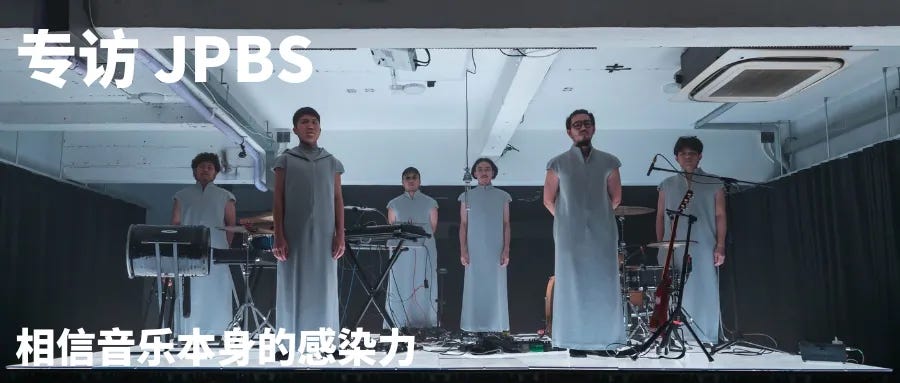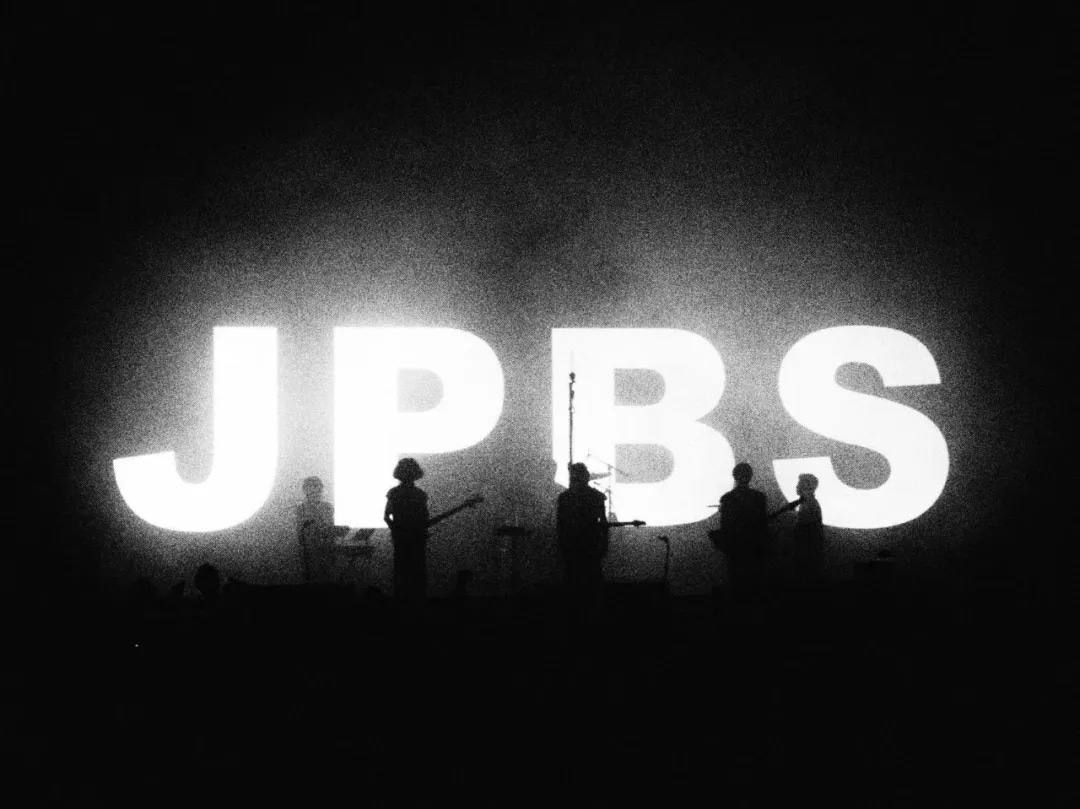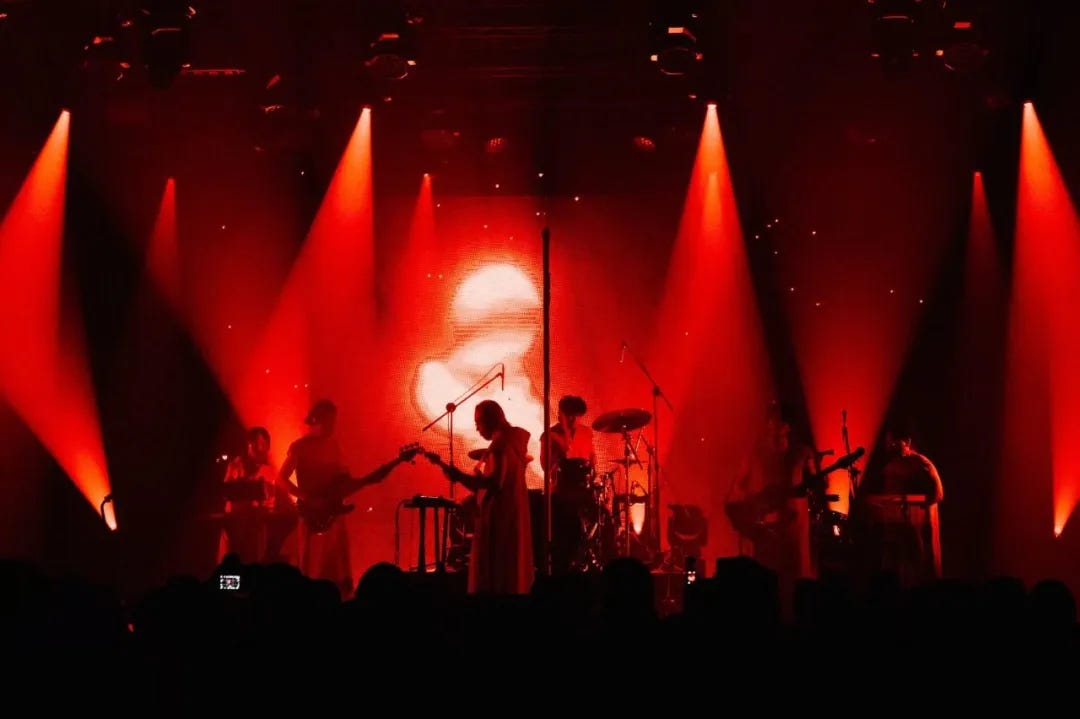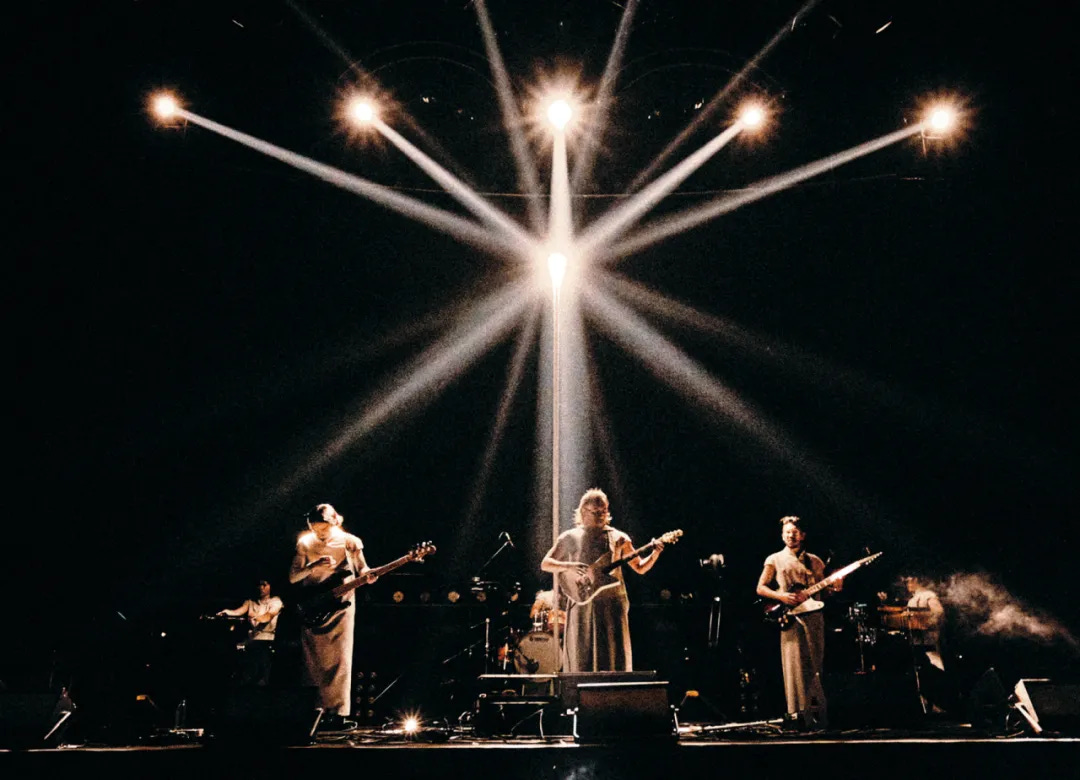无论是首张专辑《Waiting Room》,或前阵子于 Can Festival 上带来的“视听一体”的现场表演,JPBS 都成为今年器乐乐迷们最乐道的乐队之一。而在与 Space Circle 开展合作以来,这支充满抱负的乐队也有更多的新计划即将与听众们见面,本期 UPEE 有幸与 JPBS 进行一期专访,分享从专辑创作到现场演出的体会。
UPEE:你们以后摇乐团活动开始是 2012 年,至发行第一张专辑《Waiting Room》中间相隔了 11 年。在这张专辑中听众可以感受到你们变化于明丽与黑暗之间的编排美感,在电气、采样、泰国宫廷音乐等更多元素里感觉到你们写作的丰富——可以分享你们是如何探索出现在的风格和状态的?
JPBS:2012年,我们怀着对后摇音乐、盯鞋与音墙风格的兴趣组建了乐队。不过,自乐队初次亮相后的这十年间,我们的人生和音乐喜好都有诸多变化。我们觉得后摇音乐与我们的共鸣在逐渐减弱,也感觉被这种“风格”的定义束缚住了,于是我们回归根源,重新挖掘历史去再次理解它。或许这张专辑,正是我们彼时对后摇音乐理解的一种全新诠释。
这张专辑最初的构想是探索一些更为“极端”与“动态”的元素,所以这就是为什么我们开始融合并尝试多种风格与元素引用。我们还以“生、死与中间状态”这一概念为脉络来创作这张专辑,音乐与概念在创作过程中同步发展——我们融入了诸多音乐风格与音效设计,例如厄运金属、盯鞋、电子/舞曲音乐等,将其作为媒介,去传达专辑及每首歌曲特定的概念。
We started the band in 2012 with interested in post-rock music, shoegaze & wall of sound style - but along the 10 years journey since debut we been through many changes in life and also music interested, we feel that post-rock are less resonate with us and feel too stuck with the definition of the sound of it, we get back to the root. digging the history to understand it again, and maybe this album is a reinterpretation of how we understand post-rock at the time.
The initial ideas of this album was to explore something more ‘extreme’ & ‘moveable’, so it's become why we started to mix and experiment more on many style and references, and we also developed this album through the concept of ‘life, death and in between’ which the music and concept were developed parallely on the process - the many music style and sound design ex; Doom Metal, Showgaze, Electronic / Dance Music were involved to use as a medium to convey the particular concept of that songs and album.
UPEE:关于第一张专辑,为何想到以“Waiting Room”为题?可以分享“遗落世界”(LIMBO)这个概念从灵感到“音乐化”的过程吗?
JPBS:第一张专辑的一切都从“LIMBO”开始,那是我制作这张作品 Demo 期间玩的一款游戏。当时,我深深着迷于“Limbo”这个词,便开始探究它的含义,偶然在网上看到一篇题为《俄罗斯科学家揭开谜团:遗落世界(Limbo)究竟在哪里?》的抽象文章。文章讲述了一位科学家发现了一颗星球,据说我们死后会前往那里,还探讨了如何前往等等。我一眼就看出这篇文章是个整活,但它确实激发了我的灵感,成了这张专辑的灵感来源。“Limbo”一词的含义会因语境不同而有所差异。在基督教中,它指的是灵魂被困住的地方——既不在天堂也不在地狱,感觉就像一个“等候室”,等待着命运的审判,却不知道审判何时到来,甚至是否会到来——一种永恒的等待。
在“Waiting Room”的语境中,重点并不只放在“等候室”本身,还探讨了与之相关的各种维度、二元性以及介于两者之间的状态。专辑包含9首歌曲,每一首都描绘了“等候室”中9个特定的场景,每首歌都有自己独特的氛围和故事——通过声音与编曲构建并营造出各自的音景。
It started with ‘LIMBO’ , the game I played during producing the demo. I fell clinging to the words Limbo so I started to dig more on this word, then accidentally crashed on one random article on the internet titled "Russian scientists solve the mystery: Where is Limbo located?" It was about a scientist who discovered a planet where we headed after we died and how we can visit and so on. I immediately knew that this article was a hoax but it really triggered me and it became a curatorial of this album. Limbo can refer to many definitions depending on the context. In Christianity refers to a place or state where souls are stuck—not in heaven, but not in hell either, it feels like a ‘Waiting Room’ waiting for judgment, not knowing when or if it will ever come—an eternal waiting.
In ‘Waiting Room’ context not just focused on only the Waiting Room itself but also explored on their spectrum, the duality and also the in between. It consists of 9 songs which convey 9 particular places in ‘Waiting Room’, each song has its own atmosphere and story - building and creating a landscape through sound and composition.
UPEE:你们除了音乐层面的探索之外,也在尝试许多其他媒介的表达方式,例如视觉。在不久前的 Can Festival 上,许多乐迷都被你们的现场视觉印象深刻——有了解到你们目前正在与 DUCKUNIT 展开合作,可以分享你们进行现场视觉创作的过程吗?
JPBS:从《Waiting Room》的发布演出开始,我们就一直与 DuckUnit 以及 BANGKOK CITYCITY GALLERY 保持合作。我们围绕“等候室”这一概念进行了大量讨论与分享,希望可以在理念与目标上达成一致。相较于以往的关于声音编排的音乐会,我们更专注于打造一场更具表演性的演出。“表演”不仅体现在音乐编排、现场音效管理上,还延伸至舞台布景、视觉设计以及灯光设计等多个方面。在我看来,两者的思维模式截然不同。表演性并非仅仅追求各元素的同步与华丽,有更深层的内涵,比如如何将舞台作为一个空间进行管理、设计乐手肢体动作——演出过程中如何呼吸、如何把控现场音效的频率等,在最终的整体体验里这些都会更具有意义。
We have been collaborating with DuckUnit and also BANGKOK CITYCITY GALLERY since the first ‘Waiting Room’ album release performance, we have been discussing and sharing a lot on the concept of Waiting Room to be on the same page and the same goal for this project, we focus to do something more like Performance than the Concert in terms of musical arrangement, Live sound managing and also the scenography and visual & lighting design, In my opinion it's totally different way of thinking between performance and concert, it's not just to make thing synchronized and flashy but its way more than that, like how to manage the stage as a space, a body movement - how to breath during the show, how to manage the live sound frequency, it's focus more on an experience.
UPEE:可以介绍你们演出和视觉里的服饰吗?你们觉得泰国的文化在你们的创作中有什么样的地位?
JPBS:就像之前问题里回答的那样,我们的现场演出更像是一场体验的设计,而着装和美学风格也是表演的一部分。我们所穿的演出服装同样属于视觉呈现的范畴,观众能直观看到也肯定能从中获得独特的感受。这些服装的设计灵感源自专辑概念,我们把自己(乐队)定位成“等候室”里的 NPC,引领观众在我们营造的音景中开启一场旅程。
我们希望展现出一种超脱人性、近乎非人的感觉,带着一种笃定而又淡漠的情绪,这种想法受到了 Ye 的着装与美学风格的启发。而这套演出服其实最初是为另一场戏剧表演设计的,我们在此基础上进行了改良。
我们生长在这片土地,它无疑在某种程度上、以某种方式影响着我们——尤其是在这张专辑的概念塑造上,它深受泰国佛教文化的影响。专辑里有一首名为《Chowsex》的歌,讲述的是一段地狱之旅,这首歌由泰国最知名的内容创作者/说书人之一普里查·让德(Preecha Ruangdet)讲述。就我个人而言,现在回过头来思考泰国文化,有时会让我有些困惑——作为一名在泰国生活了三十年的泰国人,我发现“泰国文化”其实是一个大熔炉,融合了众多的元素。我们与东南亚邻国有很多相似之处,同时受印度和中国文化的影响也很深。在我看来,泰国文化的独特之处就在于我们如何将这些多元元素巧妙融合,而这一点也深刻地影响了 JPBS 这个项目和这张专辑。
Like what just answered in the previous question, it's more like an experience design, also the outfit and the aesthetic is a part of the performance, the costume we wore is a part of the visual as well, the audience can see it and it makes the feeling of something for sure. The idea of this outfits are also come from the album concept, we position ourselves (a band) as a NPC (non-player character) in the ‘Waiting Room’, to take all of the audience journey through a soundscape we created, We want something inhuman or beyond human feeling, with a sense faith and emotionless, it was inspired by Ye’s clothing and aesthetic. This costume was actually being used for another theatre performance and it was developed from that one.
We born and raised here, it's absolutely influence us deeply someway somehow- especially in the Concept of this album it's heavily influenced by the belief of Thai Buddhism, one song called ‘Chowsex’ is about the journey in a Hell, was narrated by Preecha Ruangdet one of the most famous Content Creator / Storyteller in Thailand. For me right now, thinking about Thai culture is a bit confusing to me sometimes because after being Thai for 30 years I’ve found that ‘Thai’ is a super mix. We are a melting pot. We shared a lot with our South East Asian neighbours and others mostly influenced come from Indian and China. It feels more like a Thainess is about how we make a unique blend, and that's influenced a lot in this project and album.
UPEE:除了现场,你们的专辑实体视觉也充满创意。《Waiting Room》封面的八芒星可否有特别的含义?你们是如何从专辑概念的“空间”,想到海报里的“地图”和“说明书”这样的形式的?
JPBS:也因为这张专辑描绘的是一场深入“等候室”的旅程,专辑中的9首曲目各自基于不同的构思和场景设定。因此我考虑制作一份地理地图和概念地图,让听众能更深入地探索专辑概念,了解专辑所构建的情境,这些信息都会通过地图呈现出来。
说实话,最初看到那些八芒星图案时,它们本身并没有任何特定的寓意,但我一眼就觉得它们是特别契合的,就像“砰!”的一声,有一种爆炸般的冲击力,这种感觉和专辑的声音风格非常契合,也像来自 cult 文化里的符号。不过后来深入探究发现,八芒星在许多文化中都有多种不同的含义。但对我来说,它的寓意会随着时间而改变,就目前而言,它对我来说代表着“一体”。
Because this album is about a journey into a world of Waiting Room, and those 9 tracks are significantly happened in a very different ideas and areas, so I thinking about to have this Geography map and also Conceptual map for audience to explore more on the concept and can get into more context of the album which show you on those map.
To be honest, at first I found those eight-pointed stars- it stands for nothing but it just immediately felt right to me, like a boom! sound, an explosion which is very related to the sound of the album, feels more like a symbol from the cult. But after researching more it also stands for many definitions in many cultures. But for me its meaning can change through time, right now for me it stands for ‘oneness’.
UPEE:正如你们之前有提到,你们一直在探索音乐的“新形态”或“新载体”。你们觉得音乐创作与视觉的关系是如何的,对于你们而言?
JPBS:我们觉得我们的音乐,就拿《Waiting Room》来说,本身就是极具画面感的。在创作这些作品时,感觉就像是在某种程度上拍摄一部电影或者创作一部小说,构建一个完整的世界。打个比方,如果这世界是一场游戏,我们的音乐就如同一张地图,仅仅勾勒出地形与景观,而我们乐队成员就像是游戏里的NPC,等待着“你”这位玩家来到这个世界中探索。
对于现场演出而言,我相信音乐本身就拥有强大的感染力,足以与观众产生共鸣。当音乐与视觉元素相结合时,那种感染力会更加强大——视觉元素填补了NPC与玩家之间的“距离感”,能够帮助拓展音乐所营造的世界边界,二者结合能让音乐更具深度与意义,更深入地带来触动。
We feel that our music (Waiting Room) is also a very visual one, at the time we producing these it feel like we are make a film or a novel someway, building the world - Metaphorically, if it were a game, our music is like a map, only a terrain / landscape, and we are NPC, waiting for ‘you’ a player to come explore in this world.
But for the live performance I truly believe in music itself is powerful enough to speak with people, but with visual I can feel that it's way more powerful - it fill the gap between NPC and player, its can help to expand the area of the music and together it can be more meaningful and reaching more deeply to people.
UPEE:乐队名“JPBS”取自潮州话“吃饱没事”(Jiā Bǎ Pò Suì)。在来到 Can Festival 之前,你们对在中国演出有什么期待吗,例如想要去的地方或美食?关于 Can Festival 有没有什么特别的回忆或者有趣的事发生可以在此分享?
JPBS:是的,我们大多数人之前都没去过中国,所以这次能去中国演出,大家都特别兴奋。在 Can 的这场演出真的太棒了,现场观众非常热情,其他参演的阵容也实在强大。我们年轻时就也是其中一些乐队的粉丝了。
这是第一次有乐迷会排长队等着我们签名,并且他们都十分友善!晚上结束后,我们还和法兹一起出去闲逛、聊天。我们第一次见面是在曼谷的 Mahorasop 音乐节上,而这次是我们第一次一起喝酒,很有意思。不过,这次行程安排得有些仓促,我们没太多时间去四处逛逛、看看风景。希望下次再来的时候,我们能有机会去看看或者爬山,看看小时候在武侠电影里见过的那种竹林。
Yes, most of us have never been to China before and it's very exciting to be there. The show at Can is truly amazing, the audience as well and the line-up is crazy. We were also fans of some of those bands when we were young. It was the first time we got a very long queue of fans to let us sign on something and they were all very nice! At night after the show we hung out and chatted with our friend ‘Fazi’. We first met at Mahorasop Festival in Bangkok and this was the first time we drank together and it was fun. But this trip is a bit rushed and we don't have much time to explore and see things. Hope next time we can see or visit a tall mountain, a bamboo forest that we saw in a Wuxia film when we were kids.
UPEE:许多乐迷也正在期待你们日后的作品,可以在此透露你们接下来的创作吗?
JPBS:Extreme!






